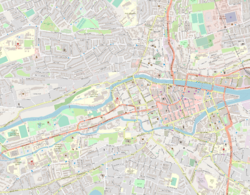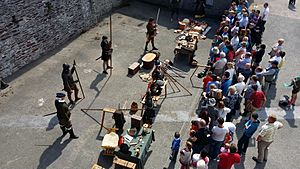Elizabeth Fort facts for kids
Quick facts for kids Elizabeth Fort |
|
|---|---|
| Cork, Ireland | |

Elizabeth Fort circa 1866
|
|
| Coordinates | 51°53′40″N 8°28′39″W / 51.894497°N 8.477617°W |
| Type | star fort |
| Area | c.1.5 acres (0.61 ha) |
| Site information | |
| Controlled by | Cork City Council |
| Open to the public |
Yes (Tuesday to Saturday 10-5 and Sunday 12-5) |
| Site history | |
| Built | 1601 |
| Battles/wars |
|
Elizabeth Fort is an old, strong fort from the 1600s. You can find it on Barrack Street in Cork, Ireland. It was first built on a high hill outside the city walls to protect Cork. But over time, the city grew bigger and surrounded the fort.
The fort then had many different jobs. It was a place for soldiers, a prison, and even a police station. Since 2014, Elizabeth Fort has become a cool place for visitors to learn about history. In 2015, about 36,000 people visited it! You can walk on the fort's walls, which have been open to everyone since September 2014.
Contents
The Fort's Story: A Look Back in Time
Elizabeth Fort was first built in 1601. It was placed on a hill south of Cork's old medieval walls. This spot was chosen because the city's old defenses, like Shandon Castle and the city walls, were not strong enough against new cannons. Cannons could be placed on the hills around the city.
Building the First Fort
Sir George Carew built the fort and named it after Queen Elizabeth I. The first fort was made of wood and earth. But the people of Cork were worried. They feared the fort might be used against them by King James I. So, in 1603, the mayor and people of Cork tore it down.
However, Cork was taken back by Lord Mountjoy. The fort was then rebuilt. This early building happened where an old church used to be. This church was very old, dating back to at least the 1100s. It was known as "St Mary del Nard" or "Holy Cross del Nard." An old map from 1610 shows "Holy Roe" church inside the new fort's walls.
Changes and Rebuilds Over Time
The fort you see today was mostly built between 1624 and 1626. More work was done in 1649, possibly by Oliver Cromwell. Any parts of the old church were removed during these rebuilds.
In 1690, during a war in Ireland, Cork was a stronghold for one side. Elizabeth Fort held out for a while during the siege of Cork. But cannons were used against the city walls from a place called Red Abbey. The walls broke, and the city gave up in just four days. After this, the fort stopped being a main defense for the city. In 1719, it became a barracks for soldiers.
From Prison to Police Station
In 1817, the fort changed its purpose again. It became a prison. Many prisoners were held here before being sent to faraway places like Australia. From 1822 onwards, mostly women prisoners were kept at the fort. It was used as a prison until 1837.
Later, in the late 1800s, the fort went back to being a military base. It became a station for the Cork City Artillery. During the Irish War of Independence (1919–1921), Elizabeth Fort was used by a group called the "Black and Tans". But the British gave it up after a peace treaty was signed. During the Irish Civil War that followed, anti-treaty forces burned the fort in August 1922.
The buildings inside the fort today were rebuilt after that fire. For a short time during World War II (1939–1945), the fort had an air-raid shelter. But the rebuilt buildings from the 1920s continued to be used as a police station until 2013. After the police station closed, Cork City Council took over the fort.
Visiting Elizabeth Fort: A Heritage Site
For over 400 years, Elizabeth Fort was always busy as a military or police base. Because of this, it was not open for visitors or tourism. However, local groups and officials worked together to open parts of the fort's walls to tourists. Sometimes, markets and festivals were held there too.
After the police station closed, local history groups and city leaders wanted the fort to be fully and permanently open for tourism. In January 2014, Cork City Council officially took control of the site. They had a three-year plan to develop it for visitors.
Since 2014, Elizabeth Fort has hosted many events and festivals. These include the Cork Midsummer Festival, Cork Heritage Open Day, and the Cork Saint Patrick's Festival.
Plans were made for more improvements, like a visitor center. In 2018, the Irish Landmark Trust renovated two of the fort's buildings. These are now used as short-term places for tourists to stay.
Today, the walls and some inside areas of the fort are open to the public six days a week. You can visit from Tuesday to Saturday, 10:00 AM to 5:00 PM, and on Sundays from 12:00 PM to 5:00 PM. Entry is free!
More to Explore





